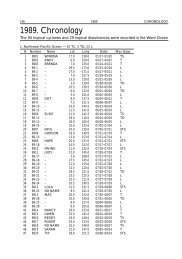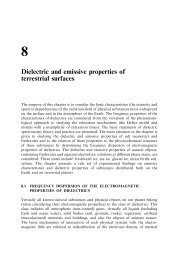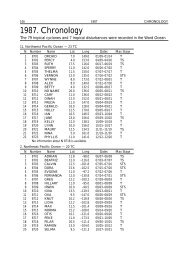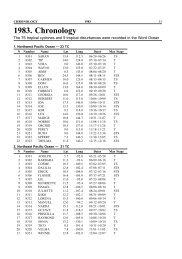Программа и тезисы докладов - Институт космических ...
Программа и тезисы докладов - Институт космических ...
Программа и тезисы докладов - Институт космических ...
You also want an ePaper? Increase the reach of your titles
YUMPU automatically turns print PDFs into web optimized ePapers that Google loves.
This work provides the results of all the stages of “Chibis-M” orientation system<br />
development: from theoretical analysis of algorithms to summer tests on the entire<br />
system. The orientation determination accuracy in different modes is analysed,<br />
and the accuracy of micro-satellite stabilization in relation to the orbital coordinate<br />
system is estimated. Apart from that, the logic of automatic switching of micro-satellite<br />
orientation determination and control modes is investigated.<br />
On the basis of design and exploitation experience the ways of “Chibis-M”<br />
orientation system modernization for the use on a micro-satellite platform of “Chibis”<br />
type are discussed.<br />
debugging oF navigaTion and aTTiTude conTrol oF The MicroSaTelliTe<br />
“chibiS-M”: MicroSaTelliTe — Macroexperience<br />
A. Ledkov 1 , V. Gotlib 1 , R. Nazirov 1 , N. Eismont 1 , V. Nazarov 1 , N. Ivlev 2 , V. Karedin 1 ,<br />
S. Karpenko 2 , F. Korotkov 1 , Y. Markov 1<br />
1<br />
Space Research Institute of Russian Academy of Sciences (IKI RAN),<br />
Moscow, Russia<br />
2<br />
LLC “Sputnix”, Moscow, Russia<br />
“Chibis” microsatellite was launched from Progress ISS transport vehicle on<br />
January 25 2012. Its principal goal is to explore the special type of lightning when<br />
the discharge is connected with outer space and roentgen and gamma rays are emitted.<br />
To reach long enough time of ballistic life of the spacecraft its orbit was raised<br />
from initial 380 km to 510 km by the use of Progress transport vehicle after it delivered<br />
the required consumables to the ISS. To fulfill the planned experiments “Chibis”<br />
systems include the attitude control instruments with required software which<br />
allow to follow the direction to the Earth center and to keep necessary power supply<br />
by targeting the solar arrays to the Sun when chemical batteries are to be recharged.<br />
As attitude sensors the sun sensors are used in combination with magnetometers.<br />
To produce the control torques electromagnetic coils are used together with momentum<br />
wheels. Onboard software was intended to calculate the model magnetic<br />
field and trajectory parameters in order to generate the required command to actuators.<br />
In the paper the problems which arose after the satellite launch are described<br />
as the methods allowed to overcome them. One of these problems was connected<br />
with magnetometers shifted measurements. The main scientific instrument to explore<br />
the lightning events is the special receiver which records the signal in VHF<br />
band. Another science instruments are gamma and ultraviolet sensors. In the paper<br />
the problems are described which are connected with programming of the scientific<br />
instrument operations taking in account of diverse external factors. The solutions to<br />
overcome the mentioned and other obstacles to fulfill the necessary operations are<br />
presented.<br />
17

















